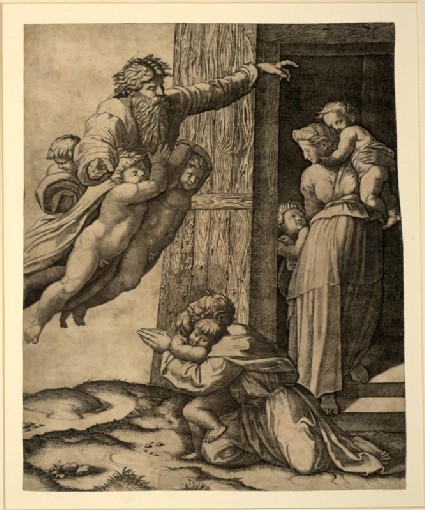Browse: 1470 objects
- Reference URL
Actions
God commanding Noah to build the Ark Raphael
-
Details
- Artist/maker
-
Raphael (1483 - 1520) (designer)Marcantonio Raimondi (c. 1470/1482 - c. 1527/1534) (engraver)
- Object type
- Material and technique
- engraving on laid paper
- Dimensions
- 305 x 251 mm (sheet)
- Provenance
-
Presented by John Ruskin to the Ruskin Drawing School (University of Oxford), 1875; transferred from the Ruskin Drawing School to the Ashmolean Museum, c.1949.
- No. of items
- 1
- Accession no.
- WA.RS.STD.015
-
Subject terms allocated by curators:
Subjects
-
References in which this object is cited include:
References
Bartsch, Adam von, Le Peintre Graveur, 21 vols (Vienna: J. von Degen, 1803-1821), no. 3
Ruskin, John, Catalogue of Examples Arranged for Elementary Study in the University Galleries (Oxford: Clarendon Press, 1870), cat. Standard no. 15
Bartsch, Adam von, The Illustrated Bartsch, founding editor Walter L. Strauss, general editor John T. Spike (New York: Abaris Books, 1978-), no. 4
Ruskin, John, Catalogue of the Reference Series Including Temporarily the First Section of the Standard Series (London: Smith, Elder, [1872]), cat. Standard no. 15
Ruskin, John, ‘Ariadne Florentina: Six Lectures on Wood and Metal Engraving. Given Before the University of Oxford, in Michaelmas Term, 1872’, Edward T. Cook and Alexander Wedderburn, eds, The Words on John Ruskin: Library Edition, 39 (London: George Allen, 1903-1912), 22
Ruskin, John, ‘The Ruskin Art Collection at Oxford: Catalogues, Notes and Instructions’, Edward T. Cook and Alexander Wedderburn, eds, The Works of John Ruskin: Library Edition, 39 (London: George Allen, 1903-1912), 21, cat. Standard no. 15
Location
-
- Western Art Print Room
Position in Ruskin’s Collection
Ruskin's Catalogues
-
Ruskin's Catalogue of Examples (1870)
15. God commanding Noah to build the Ark. (Marc Antonio, after Raffaelle.)It is placed among the Standards, because, though not absolutely good work, it represents a great school in Italy, which is distinguished by the dignity of its aim and the simplicity of its treatment. This school allows few sources of pleasure in painting except those which are common to sculpture; and depends for expression chiefly on the action of the figures, the division of the lights and darks broadly from each other, and the careful disposition of the masses of drapery, hair, or leaves, without any effort to complete the representation of these so as to give pleasure by imitation, or by minor beauties. Very often, however, such details, kept within these conditions of abstraction, are introduced in great quantity and division, (as the graining of the wood in this engraving), in order to relieve the broad masses of the figures.
The style is essentially academical, and, as opposed to Dutch imitation, noble; but, as opposed to Venetian truth, affected and lifeless. It has done great harm to subsequent schools by encouraging foolish persons in the idea that to be dull was to be sublime; and inducing great, but simple painters, like Reynolds, to give way to every careless fancy, under the discomforting belief that they could never be great without ceasing to be delightful.
-
Ruskin's Standard & Reference series (1872)
15. God commanding Noah to build the Ark. (Marc Antonio, after Raffaelle.)It is placed among the Standards, because, though not absolutely good work, it represents a great school in Italy, which is distinguished by the dignity of its aim, and the simplicity of its treatment. This school allows few sources of pleasure in painting except those which are common to sculpture; and depends for expression chiefly on the action of the figures, the division of the lights and darks broadly from each other, and the careful disposition of the masses of drapery, hair, or leaves, without any effort to complete the representation of these so as to give pleasure by imitation, or by minor beauties. Very often, however, such details, kept within these conditions of abstraction, are introduced in great quantity and division, (as the graining of the wood in this engraving), in order to relieve the broad masses of the figures.
The style is essentially academical, and, as opposed to Dutch imitation, noble; but, as opposed to Venetian truth, affected and lifeless. It has done great harm to subsequent schools by encouraging foolish persons in the idea that to be dull was to be sublime; and inducing great, but simple painters, like Reynolds, to give way to every careless fancy, under the discomforting belief that they could never be great without ceasing to be delightful.





